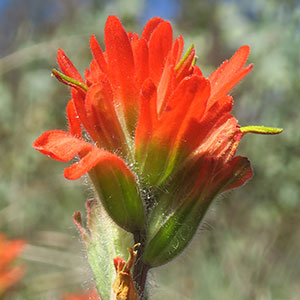Castilleja brevilobata
Castilleja minor
short-lobed paintbrush
annual paintbrush, California threadtorch, lesser Indian paintbrush, little paintbrush, seep paintbrush, thread-torch paintbrush
solitary or few, erect or ascending, unbranched, sometimes branched, hairs spreading, short, medium, and long, soft, short and medium ones short stipitate-glandular.
solitary or few, erect, unbranched, rarely branched distally, hairs sparse to dense, spreading, sometimes shaggy (var. minor), short to long, soft to stiff, eglandular and/or sparsely to densely stipitate-glandular.
green or ± yellow, lanceolate, elliptic, or oblong to narrowly ovate, 1–2(–2.5) cm, not fleshy, margins plane or wavy, involute, (0–)3–5(–7)-lobed, apex rounded to acute;
lobes ascending to erect, linear to lanceolate, apex rounded to acute.
green or purple to ± gray, linear to lanceolate, 2–10 cm, not fleshy, margins plane, sometimes wavy, ± involute, 0-lobed, apex acuminate to acute, sometimes obtuse.
3–20 × 2–3.5 cm;
bracts proximally greenish to dull brown, distally red, orange-red, or scarlet, sometimes orange or yellow, broadly lanceolate or oblong, (0–)3–5-lobed;
lobes ascending, broadly to narrowly lanceolate, short, arising above mid length, apex acute, obtuse, or rounded.
5–40 × 1–4 cm;
bracts proximally greenish, distally red, red-orange, or pale orange, rarely yellow, on apices, narrowly lanceolate, sometimes narrowly oblong to spatulate distally, 0-lobed, plane-margined, apex acuminate (oblong to narrowly spatulate in var. spiralis).
straight, 15–24(–26) mm;
tube 12–16 mm;
beak exserted, abaxial lip equal to calyx;
beak adaxially green or ± yellow-green, 7–10 mm, puberulent, stipitate-glandular;
abaxial lip deep green, reduced, rounded, 1–2 mm, 10–25% as long as beak;
teeth incurved to erect, light green, 0.5–1 mm.
straight, 13–39 mm;
tube 11–16(–20) mm;
beak partially to completely exserted, sometimes included, adaxially yellow, pale orange to red-orange, reddish brown, green, or white, 5–15(–20) mm;
abaxial lip yellow, white, red, deep red, red-violet, or green, colored as or strongly contrasting with rest of corolla, small but jutting out at 90° from axis of corolla, often readily visible through abaxial cleft, 1–3 mm, 5–25% as long as beak;
teeth spreading to strongly incurved, green, white, yellow, red, or red-purple, 0.2–1 mm.
green or whitish with green veins, lobes colored as bract lobes or paler, 14–30 mm;
abaxial and adaxial clefts 5.5–8.5 mm, 30–40% of calyx length, deeper than laterals, lateral 1.5–4 mm, 20–25% of calyx length;
lobes oblong to narrowly triangular, apex obtuse to rounded.
green or yellowish green, 13–27(–28) mm;
abaxial and adaxial clefts 6–15 mm, 33–75% of calyx length, deeper than laterals, lateral 0.5–4 mm, 5–20% of calyx length;
lobes linear to narrowly triangular or narrowly lanceolate, apex acute or acuminate.
= 24.
= 24.
Castilleja brevilobata
Castilleja minor
Castilleja brevilobata is endemic to dry serpentine openings in the Siskiyou Mountains of southwestern Oregon and adjacent California. Although sometimes treated as part of C. applegatei or C. hispida, its morphology does not suggest a close connection with either. This species occasionally hybridizes with C. pruinosa in Del Norte County, California.
(Discussion copyrighted by Flora of North America; reprinted with permission.)
Varieties 4 (4 in the flora).
Castilleja minor is a widespread specialist of seeps, saline shores, and wet ground at moderate elevations. California has many populations on serpentine substrates. Most of the varieties have distinct ranges with little overlap, with the exception of the edaphic obligate var. spiralis, which is restricted to serpentine substrates.
(Discussion copyrighted by Flora of North America; reprinted with permission.)
1. Corolla beaks 5–8(–10) mm, usually 1/3 or less of length of corollas, included to more often partially exserted from calyces. | → 2 |
2. Abaxial lips of corollas red to reddish purple; leaves linear or linear-lanceolate, soft; mountains of c, e Arizona and adjacent New Mexico southward. | var. minor |
2. Abaxial lips of corollas whitish, pale green, or pale yellowish; leaves linear-lanceolate to lanceolate, coarse; widespread in Great Basin region. | var. exilis |
1. Corolla beaks 8–15(–20) mm, usually 1/3+ of length of corollas, exserted from calyces. | → 3 |
3. Proximal bracts narrowly lanceolate or oblanceolate, distals oblong to narrowly spatulate, apices rounded or obtuse, rarely acute; abaxial lips of corollas red. | var. spiralis |
3. Bracts linear to narrowly lanceolate, apices acuminate; abaxial lips of corollas whitish, rarely greenish or pale yellow (sometimes red in c Arizona). | var. stenantha |
- Local floras:
BC,
CA,
OR,
WA
- Local Web sites:
CalFlora,
CalPhotos,
Flora NW,
PNW Herbaria
WildflowerSearch
iNaturalist (observations)
USDA Plants Database
- LBJ Wildflower Center
- SEINet
- Plants of the World Online
- Encyclopedia of Life
- Wikipedia
- Google Image Search


